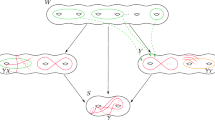Abstract
We prove that on a closed, orientable surface of genus g, the maximum cardinality of a set of simple loops with the property that no two are homotopic or intersect in more than k points grows as a function of g like \(g^{k+1}\), up to a factor of \(\log g\). The proof of the upper bound uses arguments from probabilistic combinatorics and a theorem of Scott related to the fact that surface groups are LERF.
Similar content being viewed by others
Notes
For functions f and g of several variables including k, we write \(f \lesssim _k g\) to mean that there exists a function C of k alone that satisfies the inequality \(f \le C \cdot g\) for all values of the variables. We write \(f \sim _k g\) if \(f \lesssim _k g\) and \(g \lesssim _k f\). Similarly, we write \(f \lesssim g\) and \(f \sim g\) if C can be taken to be an absolute constant.
References
Tarik Aougab, Ian Biringer, and Jonah Gaster. Packing curves on surfaces with few intersections. Int. Math. Res. Not. IMRN, (2017), rnx270.
Tarik Aougab. Constructing large \(k\)-systems on surfaces. Topology Appl., 176 (2014), 1–9
Noga Alon and Joel H. Spencer. The Probabilistic Method, third ed., Wiley-Interscience Series in Discrete Mathematics and Optimization, John Wiley & Sons, Inc., Hoboken, NJ, (2008).
Kenneth L. Baker, Cameron Gordon, and John Luecke. Bridge number, Heegaard genus and non-integral Dehn surgery. Trans. Amer. Math. Soc., 367(8) (2015), 5753–5830
Larry Guth. Polynomial methods in combinatorics, University Lecture Series, vol. 64, American Mathematical Society, Providence, RI, (2016).
I.N. Herstein, Topics in algebra, second ed., (1975).
M. Juvan, A. Malnič, and B. Mohar, Systems of curves on surfaces. J. Combin. Theory Ser. B, 68(1) (1996), 7–22
G.A. Miller, On the commutators of a given group Bull. Amer. Math. Soc., 6(3) (1899), 105–109
Justin Malestein, Igor Rivin, and Louis Theran, Topological designs. Geom. Dedicata, 168 (2014), 221–233
Adam W. Marcus, Daniel A. Spielman, and Nikhil Srivastava. Interlacing families I: Bipartite Ramanujan graphs of all degrees. Ann. of Math. (2), 182(1) (2015), 307–325
Piotr Przytycki, Arcs intersecting at most once. Geom. Funct. Anal., 25(2) (2015), 658–670
Peter Scott, Subgroups of surface groups are almost geometric. J. London Math. Soc. (2), 17(3) (1978), 555–565
Paul Schmutz Schaller, Mapping class groups of hyperbolic surfaces and automorphism groups of graphs. Compositio Math., 122(3) (2000), 243–260
László A. Székely, Crossing numbers and hard Erdös problems in discrete geometry. Combin. Probab. Comput., 6(3) (1997), 353–358
Acknowledgements
I thank Ravi Boppana, Jacob Caudell, Jonah Gaster, and Larry Guth for fun and helpful conversations. In particular, Larry laid the groundwork for constructing the “enemy graphs" of Theorem 8. I thank Dan Margalit for drawing my attention to [SS00] and the referee for unpacking the proof of Lemma 10. This work was supported by NSF CAREER Award DMS-1455132.
Author information
Authors and Affiliations
Corresponding author
Additional information
Publisher's Note
Springer Nature remains neutral with regard to jurisdictional claims in published maps and institutional affiliations.




